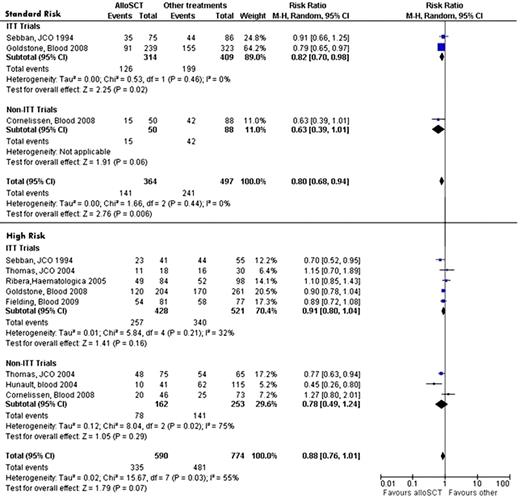Abstract
Abstract 49
The optimal post-remission therapy in adults with acute lymphoblastic leukemia (ALL) is still a matter of debate. At present, it is uncertain whether patients achieving first complete remission (CR1) should receive intensive treatment with allogeneic hematopoietic stem cell transplantation (alloSCT), autologous stem cells transplantation (ASCT) or continue with conventional chemotherapy. The aim of this study was to compare between these therapeutic options for patients achieving CR1. We conducted a systematic review and meta-analysis of randomized trials including standard risk (SR) and high risk (HR) ALL patients receiving first post-remission therapy. Trials were assessed for methodological quality. Specifically, genetically randomized controlled trials were evaluated whether the trial was analyzed by intention-to-treat (ITT) methodology. Violation of ITT was considered as the solely, most important risk of bias domain. Outcomes assessed were all-cause mortality (ACM), relapse rate and non-relapse mortality (NRM). Relative risks (RRs) with 95% confidence intervals (CI) were estimated and pooled. We identified 13 trials (17 comparisons) conducted between the years 1986 and 2006 randomizing 2648 patients. Overall, there was a significant reduction in ACM in the alloSCT arm (RR=0.88 (95% CI 0.8–0.97)) compared with ASCT or conventional chemotherapy (Fig. 1). Results were similar when only trials reporting outcomes based on ITT analysis were included (RR 0.89 (95% CI 0.82–0.97)). The number needed to treat (NNT) to prevent one death with alloSCT for the ITT trials was 17 (95% CI 9 to 50). Subgroup analysis for the trials reporting outcomes based on ITT showed that the pattern for the SR patients was similar to that of the whole group with RR=0.82 (95% CI 0.7–0.98) and NNT of 11 (95% CI 6 – 100), while the advantage of alloSCT for the HR patients was non-significant (RR 0.91 (95% CI 0.8–1.04)) (Fig.1). Overall, there was an increase in NRM (RR 2.99 (1.37–6.53)) and a decrease in relapse rate in the alloSCT arm (RR 0.52 (0.33–0.83)). There was no difference in ACM and relapse rate between the ASCT and the conventional chemotherapy arms for the whole group (RR 1.02 (95%CI 0.88–1.19)) as well as for the SR and HR groups (RR 1.03 (95% CI 0.72–1.47) and RR 1.03 (95% CI 0.91–1.17), respectively). There was no difference in relapse rate between the two arms (RR 0.92 (95% CI 0.73–1.15)) but there was a significant increase in NRM in the ASCT arm in comparison to the conventional chemotherapy arm (RR 1.77 (95% CI 1.12–2.8)). We conclude that overall alloSCT is superior to ASCT or conventional chemotherapy for ALL patients in CR1. The survival advantage is of higher statistical significance for the SR than for the HR group. ASCT and conventional chemotherapy have similar ACM and relapse rate results with a higher NRM in the ASCT arm.
All cause mortality for the comparison of alloSCT vs. ASCT/conventional chemotherapy with subgroup analysis for the SR and HR groups.
All cause mortality for the comparison of alloSCT vs. ASCT/conventional chemotherapy with subgroup analysis for the SR and HR groups.
No relevant conflicts of interest to declare.
Author notes
Asterisk with author names denotes non-ASH members.


This feature is available to Subscribers Only
Sign In or Create an Account Close Modal